- 1) Luqra: The Best for e-commerce Merchants
- 2) Stripe: The Best All-Around API for Software-Led Businesses
- 3) Adyen: The Best for Global, Enterprise-Grade Acquiring
- 4) Square: The Best “Starter to Steady” for Small Retailers and Service Businesses
- 5) PayPal: The Best for Conversion Lift with PayPal/Venmo Buttons
- 6) Braintree: The Best Developer Gateway with Vaulting
- 7) Helcim: The Best Transparent Interchange-Plus Processor for Cost Control
- 8) Stax: The Best Subscription Model for Steady, Higher Volume
- 9) Chase Payment Solutions: The Best Bank-Tied Processing and Fast Funding
- 10) Shopify Payments: The Best if you Already Run Shopify
- 11) Authorize.net: The Best Stand-Alone Gateway for Custom Stacks
- Your CPA’s Checklist for Choosing Wisely
- Picking the Best Payment Processor for Your Needs
Last Updated on November 19, 2025 by Ewen Finser
Managing payments in 2025 feels like picking a pit crew for your checkout.
You need speed, clean handoffs, and a support team that won’t panic when a fraud or chargeback spike hits when you least expect it.
Who has the best rates might seem more important, but what really saves margin is the boring stuff: stable payouts, easy-to-use dispute tools, and tax and reconciliations that don’t torch a Monday.
So in this roundup, I’m stacking the usual giants with a few standout operators that you might not already know: Stripe brings the toolbox, Square keeps it simple, Adyen goes global, PayPal still moves the needle with just a button, and Luqra’s does everything in between with a mix of risk support, analytics, and steady pricing.
The goal isn’t the “cheapest” processor — it’s the one that survives your worst week.
1) Luqra: The Best for e-commerce Merchants
What it is: Luqra is a full-stack processor that includes both a payments platform and an ERP-style back end for reporting, fraud tools, and portfolio analytics. It positions itself as a high-touch alternative to “set-and-forget” pay facilitators.
Pricing snapshot: 2.3% + $0.20 for most online card transactions; more for certain payment methods and advanced features. However, Luqra is unique in that they’ll purportedly meet or beat any quote you bring to them.
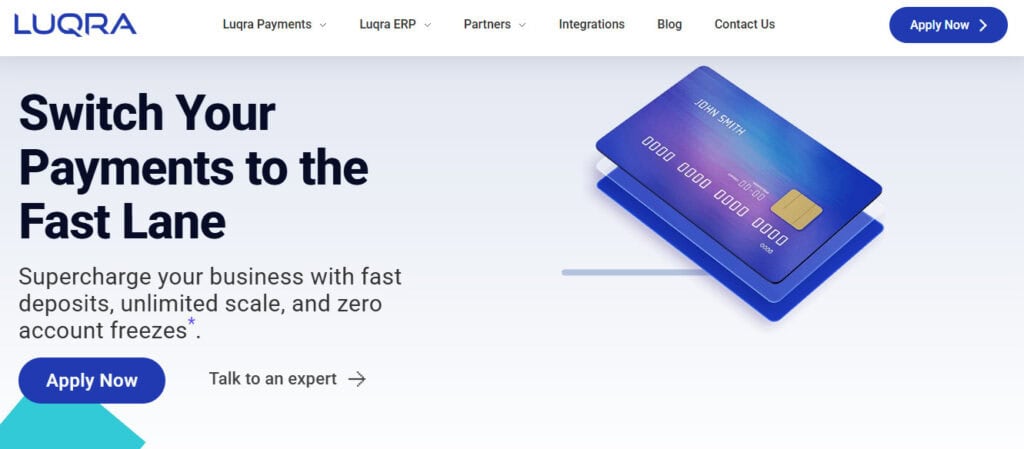
Strengths
- Pro-merchant stance on scaling and risk thresholds for online sellers.
- Portfolio-grade analytics (not just basic dashboards).
- 24/7 U.S. support and a named success manager.
Trade-offs
- To test drive the platform, you’ll need to meet up with a sales representative. You can’t just sign up for a free account and take it for a whirl since the sign-up process is extensive.
- Newer brand awareness compared to Stripe/Square.
Best for: E-commerce brands with spiky volume, subscription or dropship models, and operators who want direct access to underwriting/risk to avoid surprise throttles.
2) Stripe: The Best All-Around API for Software-Led Businesses
What it is: A developer-first PayFac with a broad product surface (Payments, Connect, Billing, Tax, Radar, Issuing).
Pricing snapshot: 2.9% + $0.30 for most online card transactions; more for certain payment methods and advanced features. Connect starts at similar list rates.

Strengths
- Battle-tested and proven, with deep APIs and tooling across marketplaces, subscriptions, and global methods.
- Mature anti-fraud (Radar) and reconciliation hooks.
Trade-offs
- Flat pricing can run higher than interchange-plus options at scale.
- Risk reviews and reserves feel opaque to first-time merchants.
Best for: SaaS, platforms/marketplaces, and dev-heavy teams that need one integration across many payment types.
3) Adyen: The Best for Global, Enterprise-Grade Acquiring
What it is: A direct acquirer in many markets, with unified risk, reconciliation, and alternative payment methods.
Pricing model: Processing fee + scheme/interchange + markup (no setup fees; pay per transaction). I like that their cost model is transparent, but quotes are often tailored, so take the posted price with a grain of salt.
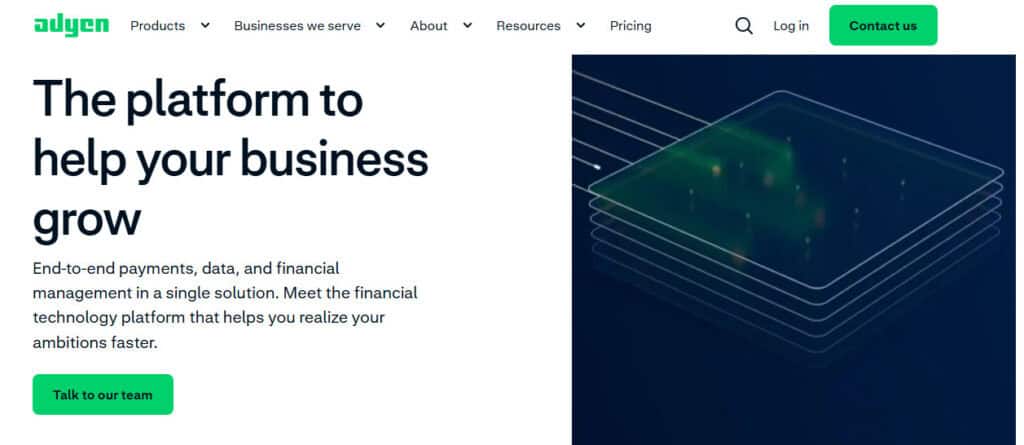
Strengths
- One contract and one platform across regions, with strong POS + e-commerce unification.
- Clear view of cost elements (interchange/scheme/markup).
Trade-offs
- In my opinion, Adyen is best for mid-market volumes; smaller merchants may find onboarding heavy.
- List pricing is indicative, but expect custom bids.
Best for: Multinational retail, marketplaces, and platforms wanting a single global spine.
4) Square: The Best “Starter to Steady” for Small Retailers and Service Businesses
What it is: If you’ve been living under a rock for the last 10 years, Square is a hardware and software bundle for POS, invoicing, scheduling, and online checkout.
Pricing snapshot: In-person 2.6% + $0.15; online often 2.9%–3.3% + $0.30 depending on product. You can get access to custom pricing above ~$250k annual volume.
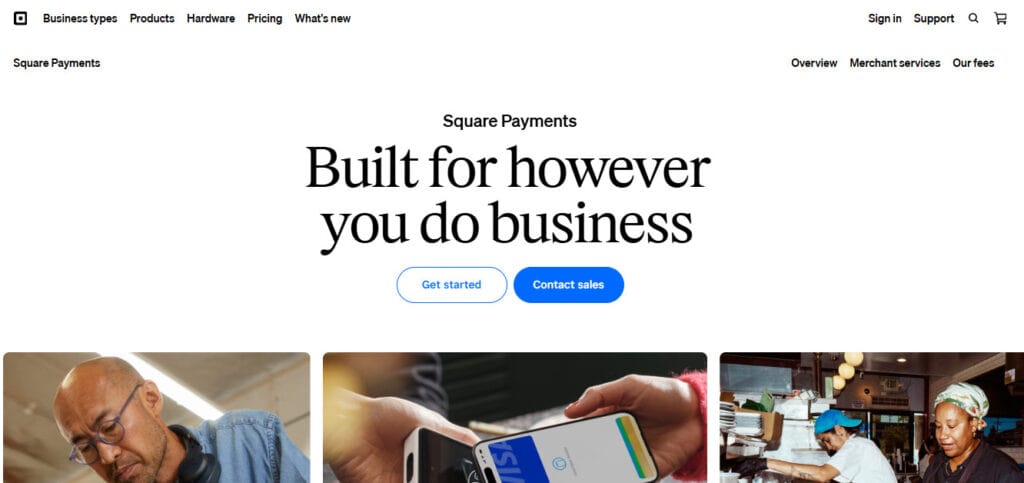
Strengths
- Fast start, strong POS ecosystem, wide add-ons. It’s ubiquitous, user-friendly, and it keeps a lot of small-shop needs under one roof.
- Clear published rates; no monthly fee for basics.
Trade-offs
- Flat rates can be above interchange-plus competitors as you scale.
- Limited rate negotiation unless you start pushing substantial volume.
Best for: SMB storefronts, pop-ups, food trucks, appointment-based services.
5) PayPal: The Best for Conversion Lift with PayPal/Venmo Buttons
What it is: Almost as ubiquitous as Square, PayPal is a consumer wallet network tied to merchant processing, invoicing, and BNPL (PayPal Pay Later).
Pricing snapshot: PayPal-branded checkout lines often price above basic card rates; they publish business fees and update policy pages with changes pretty frequently. Current costs at the time of this publication are 2.99% to 3.49%, plus a small fixed fee per transaction.
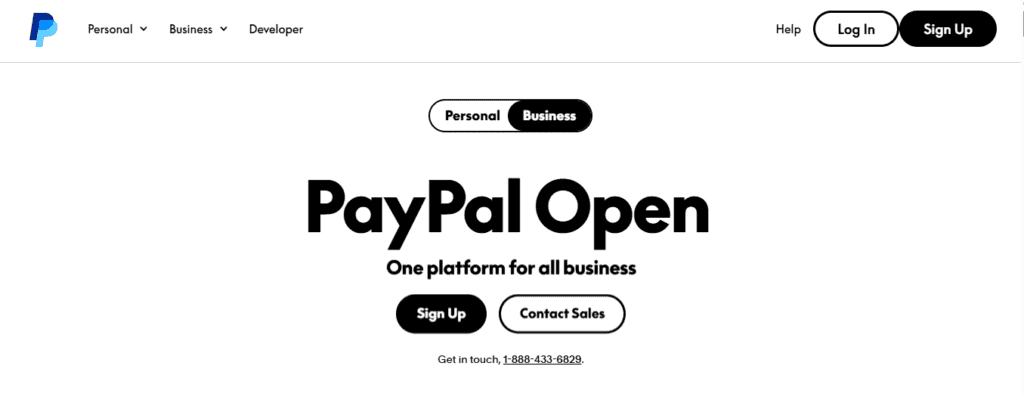
Strengths
- Trust badge and saved wallets can boost conversion at checkout.
- Venmo reach for younger buyers.
- Brand awareness can help build trust with customers, since they know PayPal will take care of their needs if there are any disputes.
Trade-offs
- Fees vary by product; some increases drew merchant scrutiny in 2025.
- Dispute workflows differ from card network chargebacks. I have also found that PayPal will very frequently side with the buyer and not the seller, which can hurt merchants.
Best for: Stores that value the conversion bump from PayPal/Venmo and sell to repeat wallet users.
6) Braintree: The Best Developer Gateway with Vaulting
What it is: A gateway + processor with vaulted cards, marketplace tools, and strong mobile SDKs.
Pricing snapshot: At the time of this writing, current card pricing is around 2.59%–2.89% + a fixed fee, with separate Venmo and ACH schedules. Actual pricing will depend on the package and date.
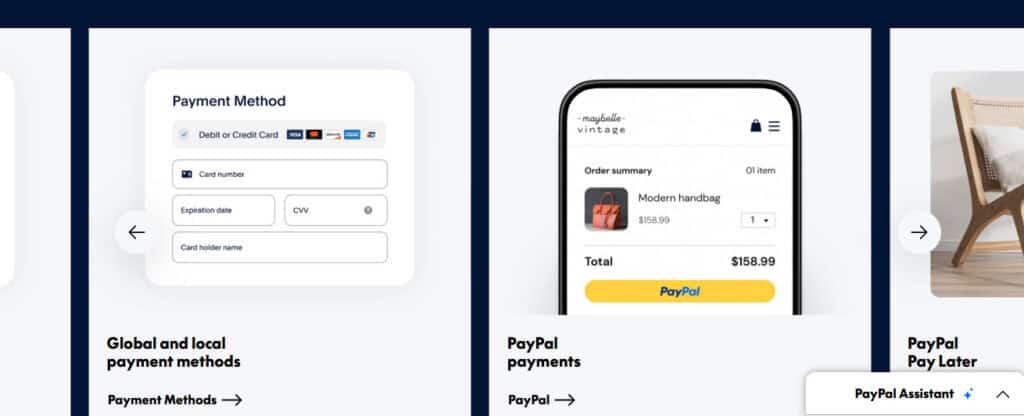
Strengths
- Mature tokenization and vaulting; solid marketplace flows.
- Native PayPal/Venmo support.
Trade-offs
- Documentation spans both PayPal and Braintree, so expect some complexity.
- Not the cheapest at small volumes.
Best for: Apps that need robust vaulting and a mix of cards and PayPal/Venmo under one roof. However, note that most SMBs don’t have strong development teams and therefore can’t get the most out of the platform.
7) Helcim: The Best Transparent Interchange-Plus Processor for Cost Control
What it is: A processor offering interchange-plus pricing with published margins and no long-term contracts. I really like this, as someone who has seen many people get locked into contracts that may not have been the best for them.
Pricing snapshot: Volume-tiered margins, with a common entry tier being interchange + 0.40% + $0.08 in-person. Savings claims vs. flat-rate peers are part of their pitch.
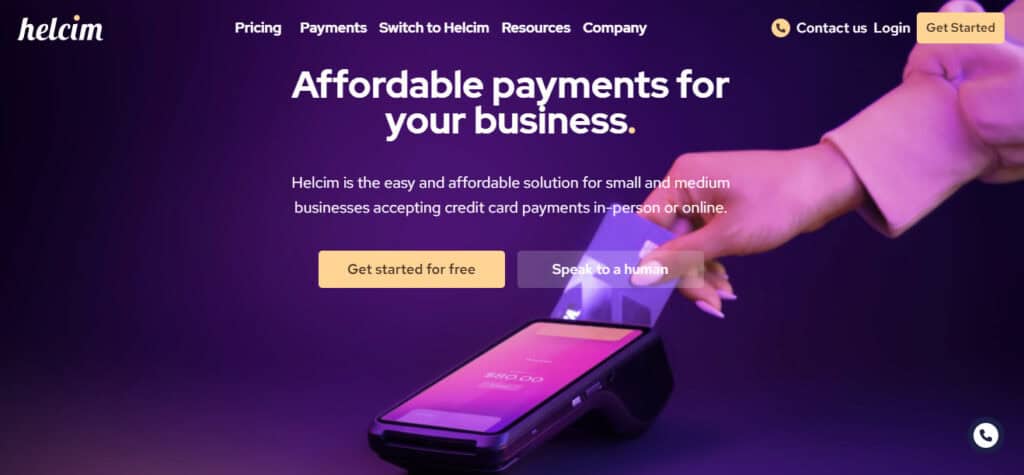
Strengths
- Clear, published interchange-plus that gives you a predictable margin.
- Invoicing, virtual terminal, and POS included.
Trade-offs
- Requires a basic understanding of interchange and scheme fees.
- Not always plug-and-play for complex platform use cases.
Best for: Businesses that value transparent cost-plus economics and can reconcile interchange flows.
8) Stax: The Best Subscription Model for Steady, Higher Volume
What it is: Stax is a processor with a subscription-plus-interchange model and a monthly fee, with zero markup on interchange. I think this one is unique, and I really like its business model — as long as it meets your use case.
Pricing snapshot: Plans start around $99/month and scale with volume; transactions run at direct-cost interchange plus network fees.

Strengths
- When average ticket and volume are stable, subscription pricing can modestly drop your effective rate.
- Good fit for established businesses that outgrow flat-rate plans.
Trade-offs
- Monthly fee hurts low-volume months.
- Requires careful math on break-even vs. flat-rate processors (not a complicated calculation, but you need to ensure you understand your numbers).
Best for: Predictable volume over $15k–$20k/month and a need to compress per-transaction margin.
9) Chase Payment Solutions: The Best Bank-Tied Processing and Fast Funding
What it is: Merchant services from a major U.S. acquirer/issuer, with funding advantages into Chase accounts.
Pricing snapshot: Rates are 2.6% + $0.10 in-person, 2.9% + $0.25 e-commerce, 3.5% + $0.10 keyed. However, there is custom pricing available. Same-day funding to Chase Checking at no extra cost is definitely a draw.
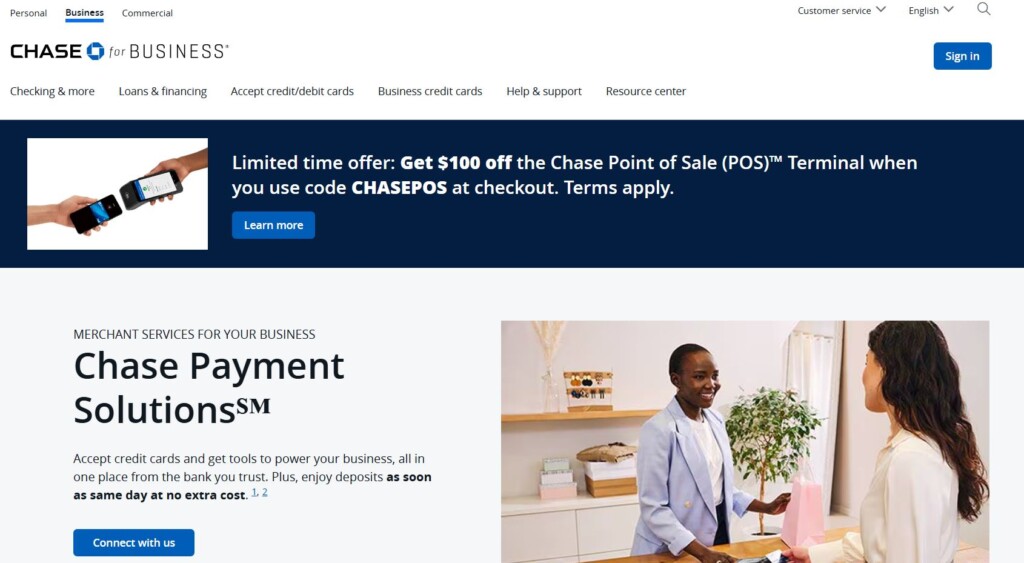
Strengths
- Bank relationship, funding speed, and broad hardware/software options.
- One vendor for banking + processing appeals to finance teams.
Trade-offs
- Contracts and add-on fees vary; make sure to negotiate (Chase can afford it).
- Portal UX can feel more “bank” than “SaaS.”
Best for: Businesses that want processor-bank alignment and quicker access to funds.
10) Shopify Payments: The Best if you Already Run Shopify
What it is: First-party payments for Shopify stores; removes third-party gateway surcharges.
Pricing snapshot: Card rates vary by plan, but they’re typically around 2.5%–2.9% + $0.30, with in-person rates by plan. Extra fees if you use an external gateway, and currency conversion adds 1.5% for U.S. stores.

Strengths
- Tightest checkout integration for Shopify; reduces friction and reconciliation.
- Works with Shop Pay, which can translate to additional conversions and sales.
Trade-offs
- Not portable beyond Shopify, and surcharges apply if you switch gateways.
- Deeper analytics/reporting often needs paid apps.
Best for: Stores committed to Shopify’s ecosystem that want fewer moving parts and a clean settlement flow.
11) Authorize.net: The Best Stand-Alone Gateway for Custom Stacks
What it is: Authorize.net is a long-standing gateway that pairs with many merchant accounts — typically used when you want to keep your acquirer but standardize the gateway.
Pricing snapshot: Common public references show a $25/month gateway fee and a 2.9% cost + $0.30 per transaction.

Strengths
- Works with a wide network of processors and CRMs.
- Keeps you flexible on the acquiring side.
Trade-offs
- Extra gateway fees and another vendor to manage.
Best for: Teams that want to decouple their gateway from acquiring to preserve negotiating leverage.
Your CPA’s Checklist for Choosing Wisely
In all honesty, most of these processors will do the same job of moving customer funds to your account at a competitive rate. They all have a glossy portal, decent support, and 1–2 day payouts.
So when picking the right processor, what will matter most are the fine details, so keep these points in mind:
- Interchange plus is typically going to be less costly than a flat rate if you’re running modest volumes.
- Excellent customer service can often make up for a slightly higher cost (think of the lost time and money for unexplained chargebacks, for example).
- Be diligent to make sure your contract explains exactly what you’re getting (e.g., how long they hold funds, what type of compliance scope they subscribe to, etc.).
Once you’ve done your due diligence, here’s how I’d go about picking the right one:
- Map your risk profile. If you run high-ticket items, subscription offerings, or dropshipping, you need clearer lines into underwriting and reserves. That points to Luqra, Adyen, or a bank acquirer with an engaged risk team.
- Decide on economics: flat vs. interchange-plus vs. subscription. Flat rate (Square/Stripe) is simpler early on. Interchange-plus (Helcim) increases transparency. Subscription (Stax) wins with volume. Run your past 3–6 months of transactions against each model to figure out where you can save the most money.
- Own your gateway logic if you value portability. Authorize.net can help you avoid lock-in; PayPal/Braintree or Shopify Payments tie value to their ecosystems.
- Look beyond list rates. Chargebacks, redemption fees, cross-border, and alternative methods can swing effective rates by 30–80 basis points. Ask for a line-item rate table and dispute fee schedule.
- Test payouts and freezes. Confirm deposit timing and the conditions that trigger holds. For e-commerce sellers with spiky demand, consider processors like Luqra, which commit to fewer freezes and faster deposits.
Picking the Best Payment Processor for Your Needs
Every processor can clear a $50 sale. The real test is the ugly week: a product launch surge, a card brand fraud alert, or a chargeback streak.
A few callouts:
- If you’re a dev-led SaaS, Stripe gets you global rails in one SDK.
- If cost transparency is king, Helcim’s published interchange-plus keeps margin honest.
- If you want banking and payouts under one roof, Chase is a practical pick.
- If you sell online at scale, Luqra earns a hard look thanks to its rate commitments, “no freezes” stance, and ERP-class analytics that make disputes and deposits less of a black box.
Before you sign, rerun last quarter’s transactions through three models (flat, interchange-plus, subscription), include dispute/network extras, and check your worst-case funding timeline. That exercise will pay for itself.

